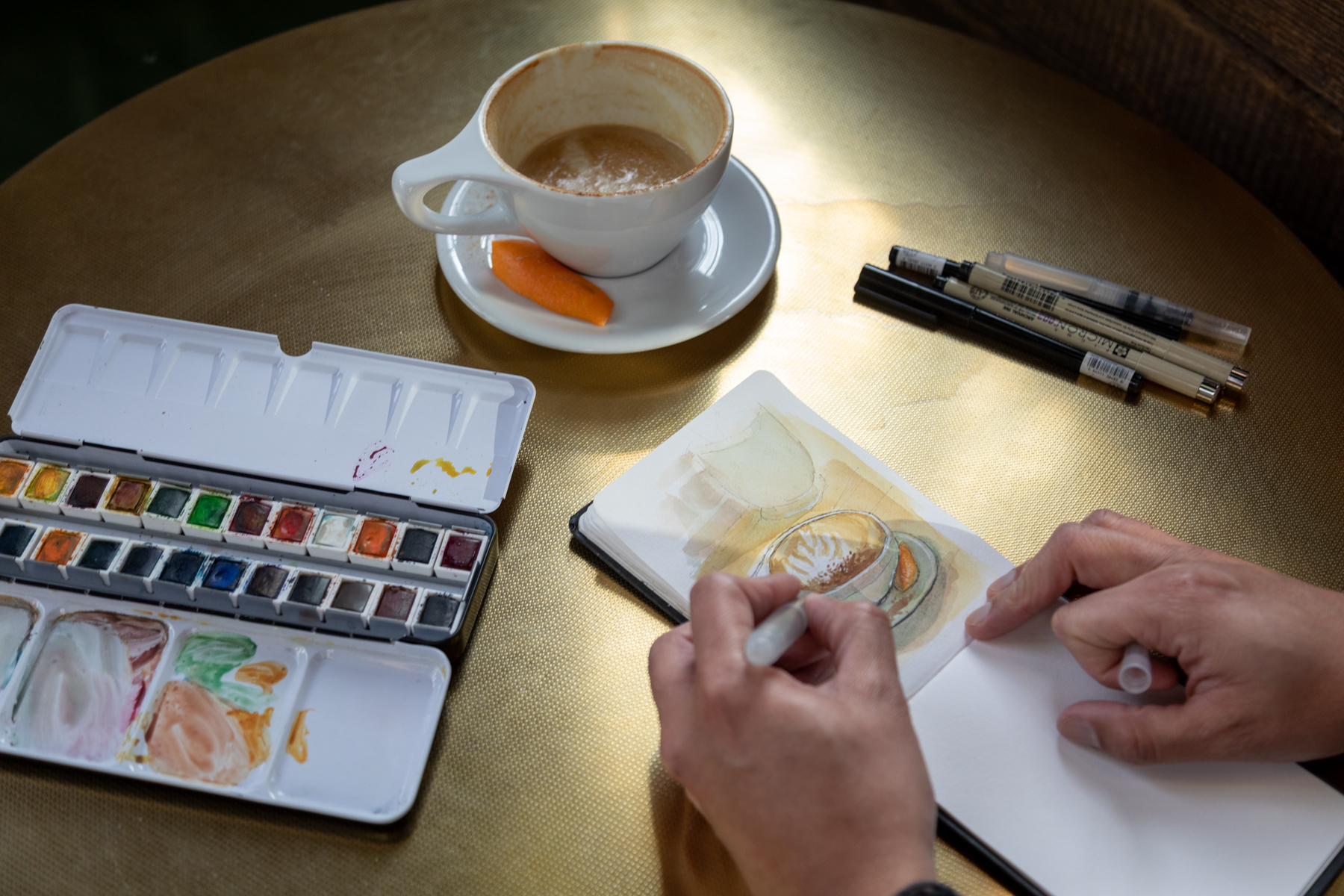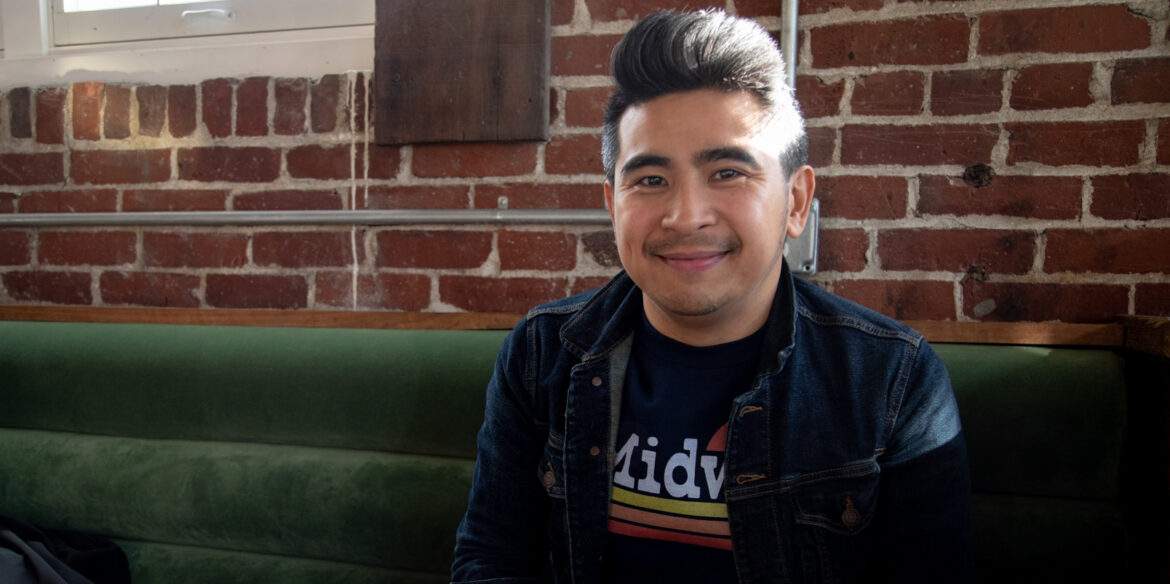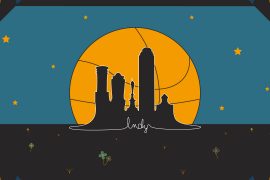January’s CreativeMornings took place at Newfields, where the conversation centered around the theme of ‘Sanctuary.’ In a packed room, they invited Jingo M. de la Rosa to the stage to discuss his life story, career, and how he got to where he is today. Following his speech, PATTERN got to talk to de la Rosa about this month’s theme of ‘habits’ and how they impact his life as an artist.
De la Rosa is an illustrator and professor, with work ranging from painting a mural in Indianapolis’ basketball arena Gainbridge Fieldhouse to teaching at Herron School of Art and Design, IUPUI and Butler University. De la Rosa grew up in Manila, Philippines and moved to Indianapolis following college. It was a struggle, however, going from living in a densely populated city to living in the suburbs. De la Rosa also struggled with English, as his textbook-level knowledge was far from conversational. Honing his hoosier lingo was a skill he had to learn over time. “Being away from everything I knew and loved was a huge change,” de la Rosa says. “Being uncertain of my professional career was another thing. It was pretty much hitting the reset button and not really knowing where my life or career was going to go.”
Eight years. That’s how long de la Rosa worked other jobs around town before he was able to work professionally as an artist. He notes that waiting was hard, but it ultimately taught him valuable life lessons. “It taught me to endure in a lot of ways,” de la Rosa says. “I’ve learned that waiting is a good thing. As far as how it impacted my career in the arts, it taught me to be more grounded and grateful that I’m at this point in my life and career.”
How did de la Rosa get involved in the arts in the first place? He mentions a quote by Picasso, “Every child is an artist. The problem is how to remain an artist once we grow up.” For de la Rosa, outgrowing art was never the case. Rather, he was consuming and engaging with art as much as he could. He also reflects on how in most Asian households, children tend to go the route of living out their parent’s dreams, without always being able to pursue their own dreams. For him, though, this couldn’t be further from the truth. “My parents went against the grain and supported me. If it wasn’t for that, I wouldn’t be pursuing art,” de la Rosa says. “My interest in art propelled me as did the encouragement from my loved ones—that combination alone was enough for me to pursue this career.”

Encouragement and skills on their own, however, aren’t always sufficient to be successful in the arts. De la Rosa says that we need to understand talent is not enough—something he tells his students on the first day of class. “Talent is important, your skills are important, you have to work on it constantly, but you also have to be a professional,” de la Rosa says. “Be a professional artist—emphasis on the word professional.” He notes that there are other skills one needs in order to make it as a professional artist. To name a few, he suggests communicating well with clients, showing up on time and being reliable, meeting deadlines, and understanding your finances and taxes.
Having had to work seven days a week at one time in his life, de la Rosa discusses how he doesn’t buy into the hustle culture that has become popular in recent years. “It’s not good for you mentally, emotionally, physically and it’s not going to produce good work either,” de la Rosa says. “So as far as time management goes, we need to prioritize rest as well.” In addition to rest, de la Rosa also notes how important structure is in his day-to-day life. He encourages artists to make time to do art that is not work, but something they enjoy a couple of times a week. “Working as an artist can be a blessing and a curse because it’s both my livelihood and my passion,” de la Rosa says. “I have to treat it as an actual job, so the real routine is making sure I have structure and making sure I am making art that is enjoyable for me.”
Making art that is enjoyable is also key to avoiding burnout, something de la Rosa has plenty of advice for keeping at bay. “We need to have boundaries with work as well,” de la Rosa says. “It’s good to have boundaries as far as time goes, too. For example, at 5 p.m., I’m done with work. Now, I can do things outside of work.” One struggle that goes along with burning out is creative blocks. De la Rosa says that creative blocks come from two things: either you need a break or you work through it. Lack of inspiration, however, is the number one reason he finds artists struggling. “More often than not when I hear creative blocks, I hear that inspiration isn’t there. We can’t wait for inspiration to come to us,” de la Rosa concludes. “We have to work to get that inspiration, and that requires discipline. We have to be of the mindset that it’s discipline over inspiration.”
To learn more about Jingo M. de la Rosa and see the beautiful art he makes and shares with his community, visit jingodlr.com/ or Instagram.com/JingoIllo. For more information on CreativeMornings, visit creativemornings.com. Here’s to hoping we see you at the next one!




